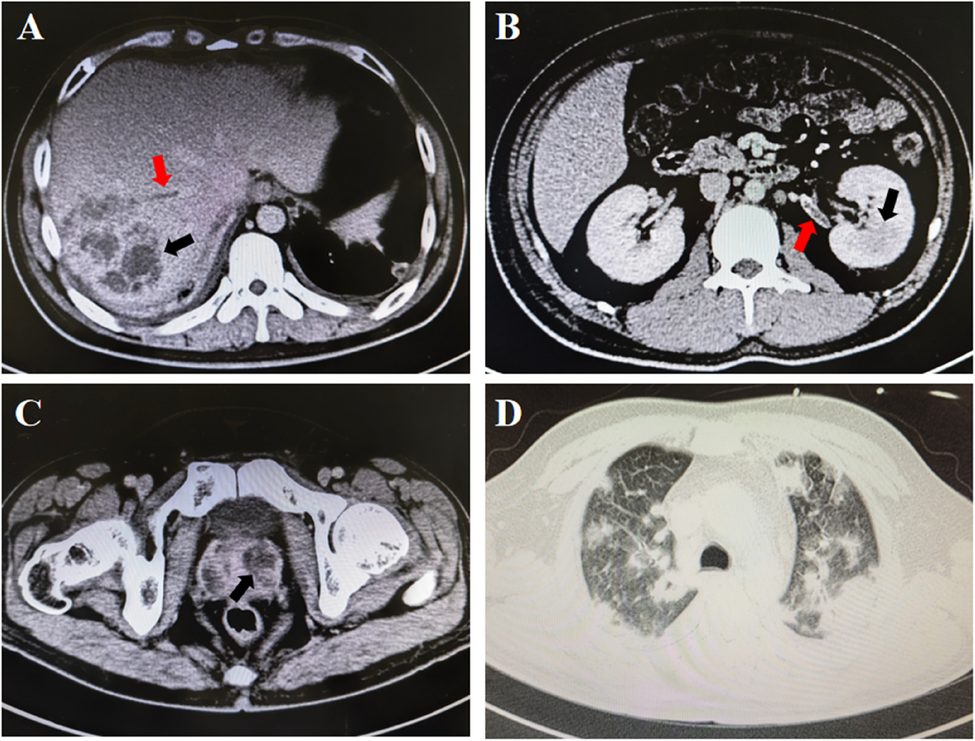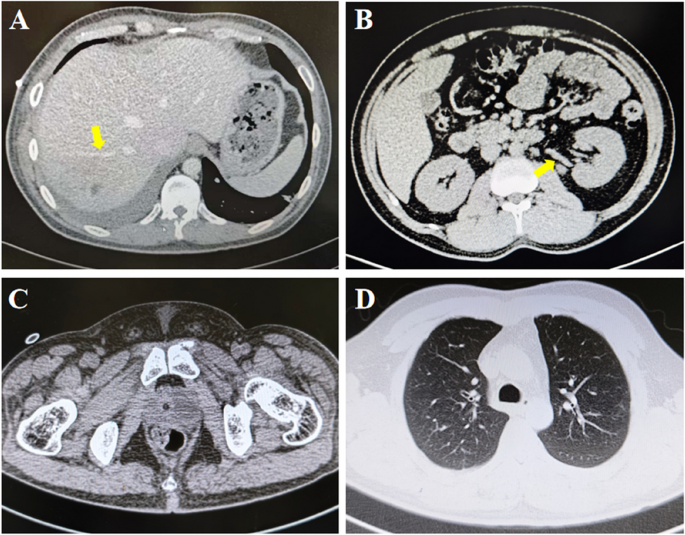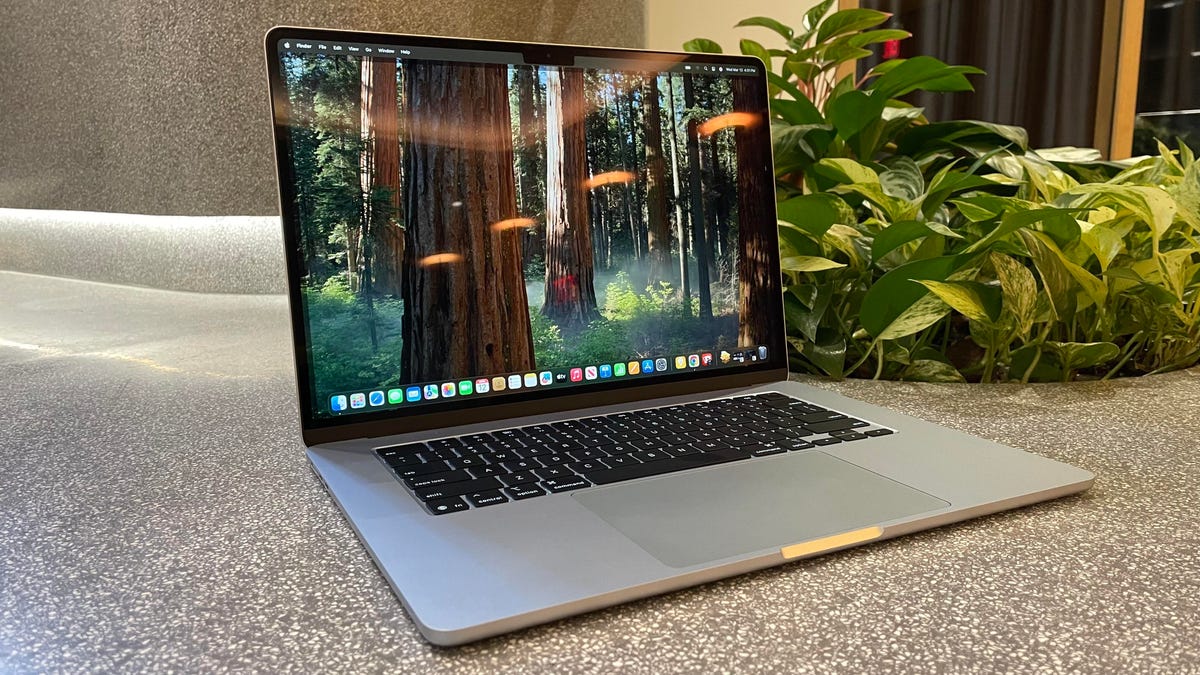- Pakistan, India exchange lists of prisoners RADIO PAKISTAN
- Pakistan and India exchange prisoner lists, urge expedited repatriation Ptv.com.pk
- Pakistan, India exchange lists of prisoners in biannual exchange Geo.tv
- India Pak exchange lists of civilian prisoners and fishermen in custody The Economic Times
- India urges Pakistan to expedite release and repatriation of Indian prisoners, including fishermen IANS LIVE
Blog
-
Pakistan, India exchange lists of prisoners – RADIO PAKISTAN
-

K. pneumoniae-induced septic embolism and prostatic abscesses in a treatment-naive type 2 diabetic patient: a case report | BMC Infectious Diseases
The patient sought medical attention a week ago due to sudden onset of generalized fatigue, dysuria, fever, rectal tenesmus, and constipation. The febrile episodes were characterized by recurrent spikes (39.4 °C) and rigors, notably without accompanying cough, sputum production, diarrhea, or cutaneous eruptions. Based on the provisional diagnosis of “hepatic malignancy with pulmonary metastases and superimposed infection” established at the local hospital, the patient received triple antimicrobial therapy with cefazolin sodium (1.5 g q8h IV) + moxifloxacin (0.4 g qd IV) + ornidazole (0.5 g q12h IV). The patient showed no clinical improvement, with persistent signs of sepsis and hypotension, ultimately necessitating transfer to our tertiary center’s ICU for further management.
On admission, the patient appeared critically ill with tachypnea (respiratory rate 30/min), facial flushing, fever (38.9 °C), blurred mind, hypotension (BP 86/55 mmHg), and a pulse of 106 bpm. His qSOFA score was 3 and Glasgow Coma Scale score was 11 (E3, V4, M4). Pulmonary auscultation identified globally diminished breath sounds accompanied by coarse moist rales throughout all lung fields, particularly pronounced in bilateral lower zones. Abdominal inspection noted significant distension with marked tenderness localized to the right upper quadrant, where hepatic and renal angle percussion elicited reproducible pain; notably absent were peritoneal signs or shifting dullness. Bilateral lower extremities exhibited grade 2 pitting edema extending to mid-calf level. Rectal examination detected a 3 × 4 cm soft, exquisitely tender mass occupying the anterior rectal wall, demonstrating localized fullness without evidence of sphincter compromise. In addition, the patient had a 5-year history of type 2 diabetes mellitus (T2DM) that was completely untreated, with no documented history of glycemic monitoring or pharmacologic intervention. Point-of-care (POC) blood glucose testing showed a concentration of 18.2 mmol/L. The patient is administered 8 units of insulin Neutral Protamine Hagedorn daily at 10 PM and 8 units of insulin aspart before breakfast, lunch, and dinner (30 min prior to each meal). Blood glucose is monitored every 2 h with the goal of maintaining levels within normal limits.
The arterial blood gas showed pH 7.48, FiO₂ 41% with electrolytes Na⁺ 129 mmol/L, K⁺ 4.2 mmol/L, Cl⁻ 103 mmol/L. Complete Blood Count shows critical leukocytosis (white blood cell 30.93 × 10⁹/L) with severe anemia (hemoglobin 89 g/L), neutrophilia (absolute neutrophil count 15.64 × 10⁹/L), and decreased red blood cell count (2.95 × 10¹²/L). Biochemistry: Marked abnormalities include albumin 20.8 g/L, C-reactive protein 154 mg/L, and procalcitonin 5.9 ng/mL, with low total protein (54 g/L), alanine aminotransferas (8.8 U/L), and uric acid (119 µmol/L). Urinalysis shows 2 + protein, 2 + white blood cells, and 4 + glucose in the patient’s urine. The patient received empiric imipenem/cilastatin 500 mg q6h + vancomycin 1 g q12h with enoxaparin 1 mg/kg q12h, Fluid resuscitation and nutritional optimization.
Contrast CT scan Showed clots were seen in the right liver vein (Fig. 1A) and left kidney vein (Fig. 1B). Multiple low-density lesions with rim enhancement in the prostate (Fig. 1C) and right liver (Fig. 1A), likely abscesses. Mildly enlarged lymph nodes noted in both groin areas. There were bilateral patchy shadows and nodules in the lungs, a small amount of pleural effusion in the thoracic cavity (Fig. 1D). The cranial CT scan shows no abnormalities in the patient’s brain. The preliminary diagnosis was sepsis and septic embolism (in the right hepatic/left renal vein) secondary to prostatic and hepatic abscesses. Under ultrasound guidance, percutaneous drainage of the right hepatic lobe and transperineal prostatic drainage were sequentially performed, yielding a significant amount of purulent fluid, with subsequent placement of an indwelling catheter in the right hepatic lobe. The drained fluid was sent for bacterial culture and metagenomic next-generation sequencing (mNGS) analysis for pathogen identification.
Fig. 1 Patient’s CT findings on admission. The patient exhibits hypodense lesions in the right lobe of the liver (A), left kidney (B), and prostate (C). Filling defects are observed in the right hepatic (A) and left renal vein (B). Additionally, there are ground-glass opacities, patchy shadows, and nodular shadows in both lungs (D). Red arrows: Filling defects. Black arrows: hypodense lesions
KP was concordantly detected across blood culture, purulent fluid culture, and mNGS. Furthermore, mNGS analysis detected the presence of resistance genes to third-generation cephalosporins and penicillins in the identified Klebsiella pneumoniae strain. Therapy de-escalated to imipenem monotherapy. Following a two-week targeted therapy regimen, the patient exhibited significant clinical improvement with concomitant normalization of laboratory parameters. Radiological assessment further revealed complete resolution of the septic embolism (Fig. 2A-B). Contrast-enhanced imaging revealed substantial abscess regression (Fig. 2A-C). Concurrent thoracic imaging showed resolving pulmonary infiltrates and minimal residual pleural effusions (Fig. 2D), prompting discharge with scheduled surveillance.
Fig. 2 
Patient’s CT findings at discharge. The patient’s imaging findings have significantly improved. The hypodense lesions in the liver (A), kidney (B), and prostate (C) have shown notable resolution. Filling has been restored in the right hepatic (A) and left renal vein (B). Furthermore, the lung tissue has returned to a normal appearance (D). Yellow arrows: Venous filling
At the 3-month follow-up after discharge, the patient was satisfied with the results of the treatment and has resumed his normal life. The ultrasound examination indicated that the prostate had returned to normal (Figure S1). After adhering to the doctor’s instructions, the patient’s blood glucose levels have been successfully controlled within the normal range. There were no adverse events throughout the process.
Continue Reading
-
Netflix’s latest channel partner is NASA – Broadband TV News
- Netflix’s latest channel partner is NASA Broadband TV News
- NASA+ is Coming to Netflix This Summer NASA (.gov)
- Netflix To Soon Allow Viewers To Binge Rocket Launches, Spacewalks Deccan Chronicle
- Nexstar set to stream NASA Live WSAV-TV
- Netflix to Integrate NASA+ Live Streaming Feeds Hits 96
Continue Reading
-

Islamabad, New Delhi share prisoners’ details under consular access agreement
ISLAMABAD: Pakistan and India on Tuesday exchanged lists of prisoners held in each other’s custody, in accordance with the 2008 Agreement on Consular Access, which requires the exchange to take place twice a year—on 1st January and 1st July.
According to the Ministry of Foreign Affairs, Pakistan handed over a list of 246 Indian or believed-to-be-Indian prisoners—comprising 53 civilians and 193 fishermen—to a representative of the Indian High Commission in Islamabad.
Simultaneously, India shared with a Pakistani diplomat in New Delhi a list of 463 Pakistani or believed-to-be-Pakistani prisoners, including 382 civilians and 81 fishermen.
Pakistan has called for the immediate release and repatriation of all Pakistani nationals who have completed their sentences and whose nationality has been verified.
Islamabad also requested special consular access for all believed-to-be-Pakistani prisoners, including those with physical or mental health conditions, to expedite the confirmation of their national status.
In its communication, Pakistan further urged India to grant consular access to all prisoners still awaiting it, and to ensure the safety, security, and welfare of all Pakistani detainees in Indian custody.
The Foreign Office reiterated Pakistan’s commitment to prioritising humanitarian matters and affirmed its continued efforts to secure the early return of all Pakistani prisoners held in Indian jails.
Continue Reading
-

Jemimah Wei and Tash Aw Tell Time and Place ‹ Literary Hub
This is Awakeners, a Lit Hub Radio podcast about mentorship in the literary arts. Robert Frost allegedly said he was not a teacher but an “awakener.” On every episode of this podcast, host Lena Crown speaks with writers, artists, critics, and scholars across generations who have awakened something for one another. We chat about how their relationship has evolved, examine the connections and divergences in their writing and thinking, and dig into the archives for traces of their mutual influence.
Article continues after advertisement
*
On this episode of Awakeners, Lena speaks with the novelists Tash Aw and Jemimah Wei, who connected when Jemimah signed up for Tash’s fiction master class on “time and place” in Singapore back in 2015.
Growing up in Malaysia and Singapore, Tash and Jemimah remember having almost no models for what it might look like to be a writer. The publishing industry – and the literary world – seemed to be headquartered elsewhere. This is why it was so important to Tash to return to his region to teach: to show young writers there what was possible.
After Jemimah had been writing for a while, Tash suggested Jemimah look into graduate school in creative writing, and later he connected her with his literary agent, who now represents them both. Ten years after the master class, their new books were released within weeks of one another, and Jemimah even traveled back to Singapore to help Tash launch his novel in the place where they met.
Article continues after advertisementIn the first half of the episode, we discuss why Jemimah stood out to Tash in class, how to make a writing life (especially coming from outside the U.S.), being “genre-agnostic,” revising book-length projects, and what to look for in a literary agent.
In the second half of the episode, Jemimah and Tash share an excerpt from The Original Daughter and The South, and we zoom in on the very themes from Tash’s master class ten years ago: time and place. We focus especially on the factors that influence how we experience time – things like age and maturity level, as well as culture, labor, economics, and the pressure to produce or succeed – and also how we experience time as readers through craft elements like verb tense and perspective, or what Jemimah calls the narrator’s “narrative perch” with respect to past or present events.
Subscribe and connect with us on our website: awakenerspodcast.com
Article continues after advertisement______________________________________
Tash Aw is the author of five novels and a memoir of a Chinese-Malaysian family, Strangers on a Pier, finalist for the Los Angeles Book Prize. His work has won the Whitbread and Commonwealth Prizes, an O. Henry Award and twice been longlisted for the MAN Booker Prize. His novels have been translated into 23 languages. As an essayist and critic, he has contributed to the Paris Review, New York Review of Books, New York Times and the Guardian, among many other publications. He is currently a DAAD Artist-in-Berlin.
Jemimah Wei is the author of The Original Daughter. Born and raised in Singapore, she is now based between Singapore and the United States. She was a Wallace Stegner Fellow at Stanford University and Felipe P. De Alba Fellow at Columbia University, where she earned her MFA. A recipient of awards and fellowships from Singapore’s National Arts Council, Hemmingway House, Sewanee Writers’ Conference, Bread Loaf Writers’ Conference, and Writers in Paradise, she was named one of Narrative’s “30 below 30” writers and is a Francine Ringold Award for New Writers honouree. Her fiction has won the William Van Dyke Short Story Prize and appears in Guernica, Narrative, Joyland, amongst others. For close to a decade, Jemimah was a host for various broadcast and digital channels, and has written and produced short films and travel guides for Laneige, Airbnb, and Nikon.
More Jemimah: https://jemmawei.com/
More Tash: https://www.instagram.com/tash.aw/?hl=en
Article continues after advertisementSubscribe and connect with us on our website: awakenerspodcast.com.
Continue Reading
-

Apple reportedly working on new MacBook that runs on iPhone chips – here’s what we know
Kyle Kucharski/ZDNET Imagine this: a MacBook running on iPhone hardware. It sounds like a far-fetched idea at first glance, but it could soon become a reality.
Also: Every iPhone model that can be updated to iOS 26 (and which ones don’t support it)
Notable Apple insider Ming-Chi Kuo took to X and wrote a short post claiming that Apple is working on a “more-affordable MacBook” that’ll run an A18 Pro chipset instead of an M-series processor like other recent MacBooks. The A18 Pro is the same type of hardware found in the iPhone 16 Pro.
Early clues
Hints of this device first appeared in July 2024 when MacRumors analyst Aaron Perris discovered various upcoming iPhone, Mac, and iPad models after scouring through macOS 15.1. Much of the unearthed information was not revealed at the time. However, MacRumors has suggested that one particular MacBook, Mac17,1, is the mystery new computer that runs on the A18 Pro.
Details are scarce, but Kuo dropped some interesting tidbits. The A18 Pro-based MacBook will have a 13-inch display, like the MacBook Air, and be available in several colors, including silver, blue, pink, and yellow. The device is expected to enter mass production sometime in late 2025 to early 2026, where it’s “projected to account for five to seven million” MacBook units.
Potential price
A MacBook running on the A18 Pro chipset is an interesting concept, especially as the line between smartphones and laptops continues to blur. The iPhone 16 Pro is an inherently powerful machine. It’s lightning fast and capable of supporting a robust ecosystem of AI features. A computer with the Pro’s hardware could potentially work as a decent midrange laptop.
The M4 MacBook Air is already fairly affordable at $849 on Amazon. At the time of writing, the price for the rumoured A18 Pro-based MacBook is unknown. However, imagine paying $600 or $700 for a MacBook — maybe less. It’s a cool idea, and it certainly has me excited. If we learn more about Apple’s apparent project, you’ll be the first to know.
Also: Your Apple Watch can see your Google calendar now
In addition to the laptop, Kuo claimed that Apple is also working on a pair of smart glasses set to release in 2027. This device will reportedly function similarly to Meta Ray-Bans, with no display functionality. However, he suggested the glasses will provide audio playback, record video, and support “AI environmental sensing,” “Multiple material options,” will be available for the “frames and temples.”
Looking for the next best product? Get expert reviews and editor favorites with ZDNET Recommends.
Continue Reading
-

FCA highlights ‘delicate balance’ to ensure growth and market integrity
Anthony Harrison, financial services expert at Pinsent Masons, was commenting on a recent speech by FCA chief executive Nikhil Rathi. In his comments, Rathi emphasised the need for a financial ecosystem that is not only globally competitive but also rooted in trust, transparency, and innovation.
“Mr Rathi’s speech highlights the very delicate balance needed to ensure competitiveness and growth while maintaining integrity and high standards across UK financial services,” said Harrison.
The UK aspires to be the world’s most innovative full-service financial centres by 2035. Financial services contribute £214 billion gross value added (GVA) to the economy, with leading sectors such as banking, insurance, and fintech. However, there are a range of challenges faced by these sectors, including market interconnectedness amplifying shocks, diverging international standards, and increasing global competition.
To tackle these challenges, the FCA has advocated for ‘outcomes-based’ regulation to better support growth, innovation and accountability. So far, reforms have set out to streamline processes for capital raising, such as listing reforms enabling transactions and the launch of the private shares trading venue PISCES. Further upcoming changes include reducing securitisation frictions, reforming prospectus requirements, and simplifying investment advice to encourage long-term investments.
Rathi set out the FCA’s aim of fostering a more open approach with firms, grounded in trust and shared problem solving. For instance, initiatives like the FCA’s artificial intelligence (AI) lab allow firms to test innovations safely, with feedback shifting away from streamlining regulations to building confidence and scaling innovation responsibly. This approach aims to strike a balance between regulatory oversight and fostering industry competitiveness, according to the FCA chief.
The FCA has also acknowledged past criticisms of being overly risk-averse, outlining steps to address them. Changes include the introduction of the consumer duty and proactive measures against financial crime. The FCA has also proposed shifts such as retiring the mortgage charter and considering differentiation in wholesale and retail market regulation, setting a goal of giving long-term confidence to firms and consumers while balancing risk and growth.
Harrison said: “The FCA appears keen to challenge criticism that it has been too risk averse in the past by championing some bigger initiatives it has implemented in recent years, such as the consumer duty and various successful actions taken in the financial crime space. However, clearly there is more to be done with the government keen to see more growth and less burdensome regulation. Mr Rathi’s comments on retiring the mortgage charter and being open to clearer client classifications applicable to investment firms signal a desire on the regulator’s part to keep pushing forward that growth agenda.”
Additionally, data prioritisation through new proportional data requirements was noted by Rathi as well as emphasis on the importance of market integrity. Rathi said that compromising standards for competitiveness is not an acceptable approach. Future opportunities were also highlighted by the FCA chief, including the UK’s potential to lead in areas such as tokenisation, appealing to younger, tech-savvy investors.
Harrison said: “Leveraging data in a smart, efficient way will play a key part in ensuring the regulator’s growth objective. It is not a surprise that the ‘p’ word, ‘proportionate’, has been cited again by Mr Rathi, as it has been by other senior FCA figures in recent speeches. It speaks, again, to the balancing act that is needed but should not be taken to mean that the regulator will be easing off on data requests.”
“Context is everything, and in certain areas, Mr Rathi has made it clear that visibility matters. With visibility come the need for the right data being produced at the right time to meet regulator requests as they come up, especially in periods of market volatility,” he said.
Continue Reading
-

Nvidia GeForce graphics cards can now play with more VRAM, thanks to DLSS update
Nvidia has tweaked the latest version of DLSS so that it eats less of your graphics card memory than before, potentially giving your Nvidia GeForce graphics card a little more room to breathe. The change comes with the release of the new Nvidia 310.3.0 Software Development Kit (SDK), which the company says reduces the VRAM demands of DLSS when using upscaling and ray tracing.
Even at lower resolutions, games with high-resolution textures and ray tracing can push VRAM usage beyond the capacities of many otherwise great GPUs, as we found in our Nvidia GeForce RTX 5060 review, with some games really pushing the limits of 8GB of memory. This is where the new Nvidia 310.3.0 SDK can lend a helping hand, reducing the VRAM usage of the new DLSS transformer model by 20%. This potentially frees up additional VRAM to give the GPU a little more headroom before performance falls off a cliff.
In our tests, as demonstrated in our RTX 5090 review, we’ve found that the new transformer model of Nvidia DLSS Super Resolution has a massive impact on image quality and stability compared to the old CNN model. Game graphics look much sharper and less blurry, and there’s much less noise and ghosting around moving objects too.
However, enabling the transformer model also results in a slight performance hit compared to the CNN model, and it also uses more VRAM, with Nvidia’s “ballpark” figures in the SDK documentation (as spotted by Videocardz) showing that a game running at 4K would need 387.21MB of VRAM for the DLSS transformer, compared to just 199.65MB for the older CNN model.
There’s still a VRAM penalty to pay for the transformer model with the new SDK, but Nvidia says that footprint has now been reduced to 307.37MB, a drop of over 20% compared to using the older 310.2.0 SDK, and the drops at other resolutions are all in the same 20% area.
That’s still a fair amount of memory to allocate just to upscaling, of course, especially when you free up over 100MB by using the CNN model at 4K instead, but it’s good to see the figures coming down. Hopefully, Nvidia is indeed planning a refresh of its Blackwell GPUs with more VRAM, as seen in the latest rumors about the RTX 5070 Super, as well as the RTX 5080 Super.
If you’re thinking of upgrading your GPU, check out our guide to buying the best graphics card, where we run you through all our favorite options to suit a range of budgets.
If you head on over to our vibrant community Discord server, you can chat about this story with members of the team and fellow readers. You can also follow us on Google News for daily PC games news, reviews, and guides.
Continue Reading
-

Frequency of pediatric HIV infection among high-risk children admitted to a tertiary care hospital at Sukkur, Sindh, Pakistan | BMC Infectious Diseases
This study highlights a concerning prevalence of pediatric HIV among high-risk children admitted to a tertiary care hospital in Sukkur, Sindh. The HIV positivity rate of 9.6% observed in our study is significantly higher than national estimates, which suggest that approximately 2.2% of total HIV cases in Pakistan occur in children under 15 years of age [1]. A striking finding is that none of the HIV-positive children had parents who tested HIV-positive, strongly suggesting a non-vertical (horizontal) route of transmission. Globally, vertical transmission remains the predominant mode, accounting for over 90% of pediatric HIV infections according to UNAIDS and WHO [12]. In contrast, 50% of our cohort had a history of unsafe injection practices and 41.7% had received blood transfusions—indicating possible iatrogenic transmission. This pattern is consistent with the 2019 Larkana outbreak, where most HIV-positive children had HIV-negative mothers and shared histories of repeated injections with unsafe equipment [7, 13].
The gender distribution in our sample showed a slight male predominance (58.3%), consistent with some international data, although no biological rationale is firmly established. This may reflect healthcare-seeking behavior or sampling variation due to the small sample size [12, 14,15,16]. Geographically, most HIV-positive children were from Sindh (75%)—notably Khairpur, Kashmor, Ghotki, and Sukkur—while the remaining 25% were from adjacent districts in Balochistan. These areas share common healthcare challenges: poor immunization coverage, inadequate infection control, and widespread use of informal healthcare services, all of which may contribute to the transmission. This distribution reinforces earlier reports that Sindh carries the highest burden of HIV/AIDS in Pakistan [6].
Clinically, failure to thrive, weight loss, and chronic diarrhea were prominent features, aligning with classical pediatric HIV presentations. It is also concerning that only 33.3% of HIV-positive children were fully vaccinated, increasing their risk of preventable opportunistic infections [6,7,8,9,10,11].
These findings highlight the urgent need for broader HIV screening criteria in pediatric populations, extending beyond children of HIV-positive mothers. The absence of vertical transmission and the strong association with unsafe medical practices call for immediate public health action, including improved infection control, stricter regulation of medical procedures, and safer transfusion protocols.
Tuberculosis co-infection was found in 16.7% of cases—slightly lower than Pakistan’s national estimate of 23% [11]. None of the children tested positive for hepatitis B or C, which differs from findings in adult HIV cohorts. This points to a localized pattern of pediatric HIV transmission, primarily driven by unsafe healthcare practices rather than maternal transmission. Efforts were made to trace all HIV-positive children identified during the study. The corresponding author personally contacted caregivers using mobile numbers from hospital records. One patient had died, and two were successfully referred to the HIV Treatment Center in Larkana for antiretroviral therapy. The remaining families, however, did not follow through with care due to transportation barriers, financial constraints, and stigma. In response, hospital administration has been notified of the HIV burden, and protocols for screening high-risk admissions have been formalized. A formal request has also been submitted to the Sindh AIDS Control Program to establish a dedicated HIV treatment unit in Sukkur, aiming to reduce reliance on referral centers in distant districts.
These findings call for immediate, multi-level interventions. Routine HIV screening should be expanded to include all high-risk pediatric admissions. Infection prevention practices must be reinforced across healthcare facilities. Public education campaigns should target early testing and reduction of stigma. Immunization efforts must be scaled up for vulnerable children. Finally, it is essential to address broader social determinants—poverty, health literacy, and care accessibility—to reduce the pediatric HIV burden in this region.
Continue Reading
-
Israel's Netanyahu expects to meet Trump next week in the US – Reuters
- Israel’s Netanyahu expects to meet Trump next week in the US Reuters
- Netanyahu set to visit White House July 7 as US pushes for end to Gaza war The Times of Israel
- Hamas accuses Israeli PM of thwarting truce talks Dawn
- Trump calls for a Gaza ceasefire deal as some Palestinians are skeptical AP News
- Updates: Israel, Gaza ceasefire possible ‘within next week’, Trump claims Al Jazeera
Continue Reading